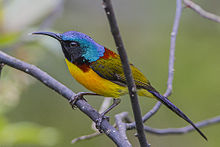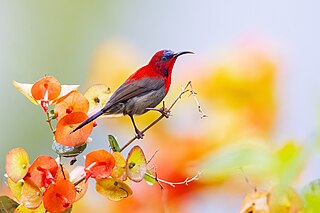
The crimson sunbird is a species of bird in the sunbird family which feed largely on nectar. They may also take insects, especially when feeding their young. Flight is fast and direct on their short wings. Most species can take nectar by hovering like a hummingbird, but usually perch to feed. It is the unofficial national bird of Singapore, as declared by the Nature Society Singapore.

The elegant sunbird is a large, up to 12 cm long, Australasian sunbird in the genus Aethopyga. The male has an iridescent blue-green crown, shoulder patch and uppertail coverts, yellow bar across lower back, red ear coverts, olive back, yellow throat, red neck collar and yellow below. The female has a yellowish olive upperparts, scaly crown and yellow underparts.
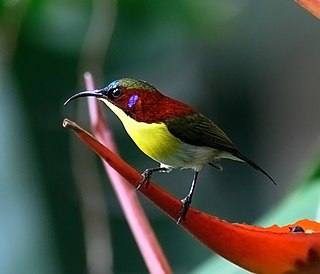
The handsome sunbird is a species of bird in the family Nectariniidae. It is endemic to the Philippines.

The Apo sunbird is a species of bird in the sunbird family Nectariniidae. It is endemic to the island of Mindanao in the Philippines.

The fork-tailed sunbird is a bird in the family Nectariniidae. The species was first described by Robert Swinhoe in 1869.

The white-flanked sunbird is a species of bird in the family Nectariniidae. It is endemic to Indonesia.
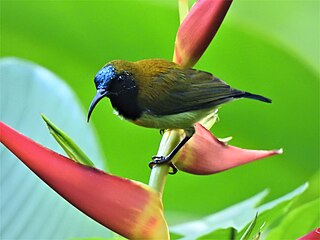
The flaming sunbird is a species of bird in the family Nectariniidae. It is endemic to the northern Philippines.

Mrs. Gould's sunbird is a sunbird species native to forests and shrublands from the southern foothills of the Himalayas to Southeast Asia.

The fire-tailed sunbird is a species of sunbird in the family Nectariniidae.

Lina's sunbird is a species of bird in the family Nectariniidae It is endemic to mountains in the island of Mindanao in the Philippines. It is one of the most striking sunbirds in the country with the male having an iridescent blue color and an orange spot on its yellow breast. It is named after Dioscoro S. Rabor's wife, Lina. Its natural habitat is tropical moist montane forest above 1000 m. It is threatened by habitat loss

The Javan sunbird or scarlet sunbird is a species of bird in the family Nectariniidae. It is endemic to Java and Bali, Indonesia. Its natural habitats are subtropical or tropical moist lowland forest and subtropical or tropical moist montane forest.

The grey-hooded sunbird is a species of bird in the family Nectariniidae. It is endemic to the Philippines. Its natural habitat is tropical moist montane forests.

The black-throated sunbird is a species of bird in the family Nectariniidae.
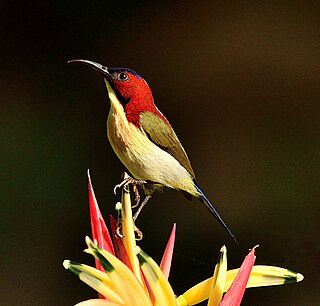
The lovely sunbird is a bird species in the family Nectariniidae. It is endemic to the Philippines. Its natural habitats are subtropical or tropical moist lowland forests and subtropical or tropical moist montane forests.

Temminck's sunbird is a species of sunbird. It is found in up to 1800 m altitude in Borneo, Sumatra, West Malaysia, and south west Thailand in tropical moist montane forests.

The Himalayan cutia is a bird species in the family Leiothrichidae. Its scientific name ultimately means "the khutya from Nepal", as Cutia is derived from the Nepali name for these birds, and nipalensis is Latin for "from Nepal".

Vigors's sunbird, Sahyadri sunbird, or western crimson sunbird, is a species of sunbird which is endemic to the Western Ghats of India. It has been considered as a subspecies of the crimson sunbird but it does not have the central tail as elongated and is restricted in its distribution.

The maroon-naped sunbird is a species of bird in the family Nectariniidae. It is endemic to the Philippines. Its natural habitat is subtropical or tropical moist lowland forests.

The magnificent sunbird is a species of bird in the sunbird family which feed largely on nectar, although they will also take insects, especially when feeding young. Flight is fast and direct on their short wings. Most species can take nectar by hovering like a hummingbird, but usually perch to feed most of the time. It is endemic to the western Philippines found in the Visayan islands of Negros Island, Panay, Cebu, Tablas Island and Romblon. It wasas once considered a subspecies of the crimson sunbird which is found in Borneo, Sumatra and Sulawesi.
